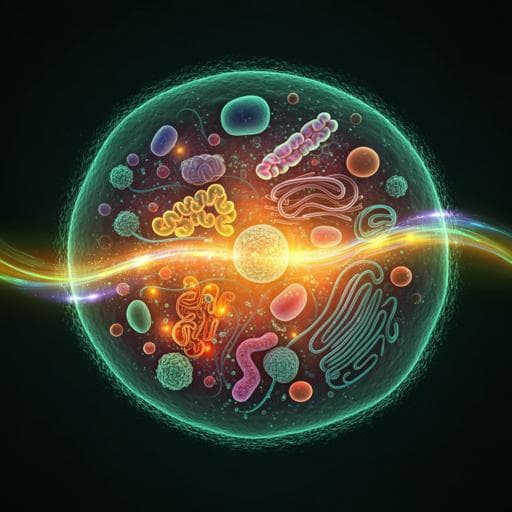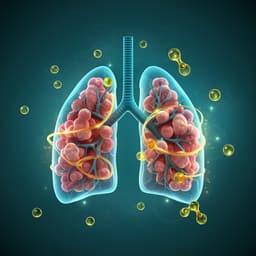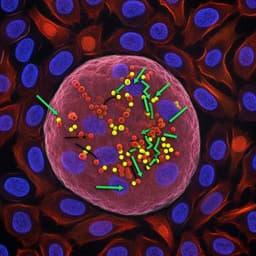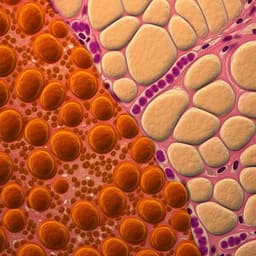
Health and Fitness
ω-6 Polyunsaturated fatty acids (linoleic acid) activate both autophagy and antioxidation in a synergistic feedback loop via TOR-dependent and TOR-independent signaling pathways
B. Yang, Y. Zhou, et al.
Discover how ω-6 Polyunsaturated fatty acids, particularly linoleic acid, can activate autophagy and a unique antioxidant feedback loop. This groundbreaking study by Bo Yang, Yan Zhou, Mengjiao Wu, Xueshan Li, Kangsen Mai, and Qinghui Ai highlights potential new therapeutic pathways for combating various diseases.
~3 min • Beginner • English
Introduction
The study investigates how ω-6 polyunsaturated fatty acids (PUFAs), specifically linoleic acid (LA), regulate autophagy and the Keap1-Nrf2 antioxidant system. Prior work has shown ω-6 PUFAs mediate antistress activities (e.g., oxidative stress alleviation, modulation of cyclooxygenase, membrane effects). Autophagy and Nrf2-mediated antioxidation are key host defense mechanisms implicated in disease pathogenesis. While ω-3 PUFA DHA has been shown to induce both autophagy and Nrf2, the molecular mechanisms by which ω-6 PUFAs regulate these pathways are unclear. Evidence suggests PUFAs can activate AMPK and influence TOR signaling; AMPK can induce Nrf2 via mTOR inhibition. There may be crosstalk between autophagy and antioxidation via the P62-Keap1-Nrf2 axis. Using large yellow croaker (Larimichthys crocea) as a model relevant to human disease biology, the study aims to determine whether ω-6 PUFAs activate autophagy and antioxidation via AMPK/TOR pathways and to test whether autophagy and antioxidant pathways form a feedback loop connected by P62-Keap1.
Literature Review
- ω-6 PUFAs have documented antistress activities, including antioxidant effects and modulation of inflammatory and membrane processes.
- PUFAs can activate AMPK and TOR pathways; AMPK is a known inducer of Nrf2 via ATP depletion and mTOR inhibition.
- ω-3 PUFA DHA induces autophagy and Nrf2 in certain cell types; autophagy and antioxidation are interrelated under antioxidant-supplemented conditions (e.g., vitamin D in ischemia/reperfusion models).
- In Atg7 knockout mice, autophagy inhibition leads to P62 accumulation and strong induction of phase II detoxifying and antioxidant genes, implicating P62-Keap1-Nrf2 crosstalk.
- Prior fish studies suggest dietary ω-6 PUFA (soybean oil) can alter antioxidant systems, but mechanisms remained unclear.
- TOR-dependent mechanisms inhibit autophagy via phosphorylation of ULK1 Ser757, ATG13 Ser355, and TFEB Ser211; some autophagy stimuli operate independently of TOR.
These works frame the hypothesis that ω-6 PUFAs may regulate autophagy and antioxidation via AMPK and TOR and that P62-Keap1-mediated coupling may create a feedback loop.
Methodology
In vivo dietary intervention: Large yellow croaker (Larimichthys crocea; mean weight ~15.4 g) were reared in sea cages (26 ± 2°C; salinity 29–32‰; dissolved O2 6–7 mg/L). Diets for 10 weeks contained 100 g/kg lipid: fish oil (FO; ω-3–rich; control) or soybean oil (SO; ω-6–rich). Fish were fed twice daily. Fatty acid composition of diets and liver was profiled (Supplementary Figs. 3–4). Investigators were blinded to group allocation.
- Transcriptomics: Liver mRNA (n=6/group) was sequenced (Illumina HiSeq 2000). Reads were processed to obtain reference sequences; ORFs predicted (TransDecoder); expression quantified (FPKM, Cufflinks). Annotation via BLASTX (Nr, Swiss-Prot) and BLASTn (Nt), GO with Blast2GO, KEGG pathways with KAAS. DEGs assessed and deposited (SRA/GEO).
- Antioxidant assays: Hepatic catalase (CAT), superoxide dismutase (SOD), glutathione peroxidase (Gpx), total antioxidant capacity (T-AOC), and malondialdehyde (MDA) measured by standard methods. AMPK activity measured by ELISA.
- Ultrastructure: Liver processed for TEM (glutaraldehyde fixation, osmium postfixation, ethanol dehydration, araldite embedding; uranyl acetate/lead citrate staining) to identify autophagosomes.
In vitro hepatocyte experiments: Primary hepatocytes from L. crocea were cultured in DMEM/F12, serum-starved 2 h, then treated 24 h with LA (ω-6) or DHA (ω-3) at indicated concentrations (LA up to 1 mM; viability assessed by CCK8).
- Autophagy measurements: Acridine orange (AO; 2 µM), monodansylcadaverine (MDC; 50 µM), and LysoTracker Red (100 nM) staining; confocal microscopy and flow cytometry (CytoFlex) to quantify autophagic vacuoles/autolysosomes (mean red fluorescence intensity).
- Gene expression: RT-qPCR (triplicate extractions; 2−ΔΔCT) for antioxidation genes (Nrf2, Sod1, Sod3, CAT, Gpx) and autophagy genes (Beclin1, ULK1, ATG101, ATG12, ATG4b, LC3, GABARA, P62, etc.).
- Protein analyses: Western blots of cytoplasmic and nuclear extracts (PVDF membranes; ECL), probing total and phospho-proteins: AMPKα (Thr172), ULK1 (Ser467, Ser555, Ser637, Ser757), raptor (Ser792), TSC2 (Ser1387), ATG13 (Ser355), TFEB (Ser211), LC3 (LC3-I/II), Nrf2 (nuclear Nrf2 with LaminB loading control; GAPDH control for cytosolic/total).
Pathway perturbations:
- AMPK: AICAR (500 µM) activator; Compound C (CC; 5 µM) inhibitor, with ±250 µM LA.
- TOR: Rapamycin (RAPA; 500 nM) inhibitor; MHY1485 (2 µM) activator, with ± LA.
Autophagy/antioxidant crosstalk:
- Autophagy modulation: RAPA (activator), 3-Methyladenine (3-MA; 2 mM) and chloroquine (CQ; 5 µM) inhibitors; effects on autophagic flux, nuclear Nrf2, and antioxidation gene expression under LA treatment.
- Nrf2 modulation: NK-252 (2 µM) activator; ML385 (5 µM) inhibitor; effects on autophagic flux and antioxidation markers under LA treatment.
P62–Keap1 interaction and transcriptional feedback:
- Co-localization: HEK293 cells co-transfected with Keap1-GFP and P62-RFP (and truncated mutants ΔKeap1 lacking DC domains; ΔP62 lacking KIR domain); confocal microscopy.
- Co-immunoprecipitation: Co-transfection of Keap1-FLAG and P62-HA (and truncations) followed by IP with anti-FLAG or anti-HA and immunoblotting to test interaction dependence on Keap1 DC and P62 KIR.
- Transcriptional regulation: Dual-luciferase reporter with P62 promoter (pGL3-P62) and ARE-site mutant; co-expression of Nrf2 (pCS2-Nrf2); assay of luciferase activity. ChIP with Nrf2-Flag to precipitate P62 promoter fragment containing ARE (−635 to −623). EMSA using biotin-labeled oligos of P62 ARE, competition with unlabeled WT or mutant oligos, and supershift with anti-Nrf2.
Statistics: Data are mean ± SEM; independent t-tests and Tukey’s test; significance annotated in figures.
Key Findings
- In vivo (SO vs FO diets): 1237 hepatic DEGs (580 up, 657 down); KEGG enrichment included mTOR, peroxisome, p53, and phagosome pathways. Antioxidant capacity decreased with SO: reduced CAT, SOD, Gpx activities and T-AOC; increased MDA. Hepatic mRNA levels of Nrf2, SOD1, SOD3, CAT, Gpx decreased; nuclear Nrf2 protein decreased. Despite no significant transcriptional differences in autophagy genes, TEM showed increased autophagosomes and LC3-II/LC3-I ratio increased, indicating autophagy induction.
- In vitro hepatocytes: LA up to 1 mM did not reduce viability. LA (250–1000 µM) increased mRNA of Nrf2, SOD1, SOD3, CAT, Gpx vs BSA control (lower than DHA). Nuclear Nrf2 increased after 250 µM LA and DHA. AO, MDC, and LysoTracker assays showed dose-dependent increases in autophagic vesicles/flux with LA, greater than DHA. LA increased mRNA of autophagy genes (Beclin1, ULK1, ATG101, ATG12, ATG4b, LC3, GABARA, P62) and increased LC3-II/LC3-I.
- AMPK pathway: LA increased AMPK activity and phosphorylation of AMPKα (Thr172) and ULK1 (Ser467/555/637) while reducing ULK1 Ser757; nuclear Nrf2 increased. AICAR further enhanced these effects and autophagic flux; Compound C reversed them, decreasing autophagic flux and lowering antioxidation gene expression.
- TOR involvement: LA increased phosphorylation of raptor (Ser792) and TSC2 (Ser1387), increased ULK1 Ser467/555/637, decreased ULK1 Ser757, ATG13 Ser355, TFEB Ser211, and increased nuclear Nrf2. MHY1485 (TOR activator) reversed LA effects (increased ULK1 Ser757, ATG13 Ser355, TFEB Ser211; decreased nuclear Nrf2 and antioxidation gene expression) and reduced autophagic flux. Rapamycin enhanced autophagic flux and antioxidation gene expression and modulated phosphorylation states consistent with TOR inhibition.
- Autophagy–antioxidation coupling: Autophagy activation (LA+RAPA) increased nuclear Nrf2 and antioxidation gene expression; autophagy inhibition (LA+3-MA or LA+CQ) reduced LA-induced autophagic flux, nuclear Nrf2, and antioxidation genes, indicating autophagy contributes to enhanced antioxidant capacity.
- Antioxidation–autophagy coupling: Nrf2 activation (LA+NK-252) increased autophagic flux; Nrf2 inhibition (LA+ML385) reduced autophagic flux and antioxidation gene expression, indicating Nrf2 promotes autophagy.
- P62–Keap1 interaction: LA increased Keap1 and P62 protein levels. Keap1-GFP co-localized with P62-RFP; deletion of Keap1 DC or P62 KIR disrupted colocalization. Co-IP showed direct interaction requiring Keap1 DC and P62 KIR, consistent with P62 competing with Nrf2 for Keap1 binding, freeing Nrf2 to translocate to nucleus.
- Nrf2 regulation of P62: Nrf2 activation increased P62 mRNA; inhibition decreased it. Nrf2 enhanced P62 promoter-driven luciferase; mutation of ARE diminished activation. ChIP confirmed Nrf2 occupancy at P62 promoter ARE (−635 to −623). EMSA showed specific binding and supershift with anti-Nrf2. Together, data reveal a positive feedback loop: autophagy via P62 sequesters Keap1 to activate Nrf2, and Nrf2 transcriptionally upregulates P62.
Discussion
The study addresses the mechanistic question of how ω-6 PUFA linoleic acid modulates autophagy and antioxidation and whether these processes are interlinked. In vivo, ω-6–rich diets induced autophagy while decreasing overall antioxidant enzyme activities relative to ω-3–rich FO diets, reflecting complex dietary fatty acid influences. In vitro, purified LA increased both autophagy and antioxidant responses compared to BSA control, clarifying direct cellular effects. Mechanistically, LA activates AMPK, which promotes autophagy through ULK1 phosphorylation and enhances Nrf2 signaling. Modulation of TOR demonstrates that LA’s effects involve both TOR-dependent (e.g., ULK1 Ser757, ATG13 Ser355, TFEB Ser211) and TOR-independent arms downstream of AMPK. Pharmacologic activation/inhibition of AMPK and TOR confirmed their causal roles in LA-induced autophagy and antioxidation.
Importantly, bidirectional crosstalk was established: autophagy promotes antioxidation (inhibiting autophagy dampened Nrf2 nuclear accumulation and target genes), and antioxidation via Nrf2 promotes autophagy. The molecular bridge is the P62–Keap1 complex. P62 directly interacts with Keap1 through its KIR motif and Keap1’s DC domain, displacing Nrf2 to drive nuclear translocation. Conversely, Nrf2 binds the P62 promoter ARE to upregulate P62 transcription, forming a synergistic positive feedback loop that amplifies both autophagy and antioxidant defenses. These results integrate AMPK/TOR signaling with the P62–Keap1–Nrf2 axis to explain how ω-6 PUFAs can coordinate stress responses, with implications for diseases where autophagy and redox homeostasis are disrupted.
Conclusion
This work demonstrates that ω-6 PUFA linoleic acid activates autophagy and enhances antioxidant responses through AMPK-dependent mechanisms engaging both TOR-dependent and TOR-independent signaling in hepatocytes. It further reveals a synergistic feedback loop between autophagy and antioxidation mediated by P62–Keap1 interaction and Nrf2-driven transcriptional upregulation of P62. In vivo dietary ω-6 PUFA increased autophagy but reduced overall antioxidant capacity relative to ω-3–rich diets, highlighting dietary complexity. These findings provide mechanistic insight into how ω-6 PUFAs modulate cellular stress pathways and suggest potential utility of ω-6 PUFAs to fine-tune autophagy–antioxidation networks in pathologies marked by oxidative stress and impaired proteostasis.
Future directions: validate these mechanisms in mammalian models and human cells; dissect dose- and time-dependence of LA; resolve in vivo dietary confounders by using purified fatty acid interventions; explore therapeutic modulation of the P62–Keap1–Nrf2 loop; assess outcomes in disease models (e.g., neurodegeneration, metabolic and inflammatory diseases).
Limitations
- Species/model limitations: primary evidence derives from a teleost fish model (large yellow croaker) and fish hepatocytes; translation to mammals/humans requires validation.
- In vivo dietary complexity: the FO vs SO comparison involves multiple fatty acid differences; reduced antioxidant capacity in SO-fed fish may reflect broader dietary lipid composition, acknowledged by authors.
- In vitro conditions: hepatocyte culture and pharmacologic perturbations may not fully recapitulate in vivo physiology.
- Quantitative detail: while phosphorylation changes and flux markers were consistent, absolute effect sizes and long-term functional outcomes were not assessed.
- Tissue specificity: primary focus on liver/hepatocytes; systemic interactions and other tissues were not investigated.
Related Publications
Explore these studies to deepen your understanding of the subject.







